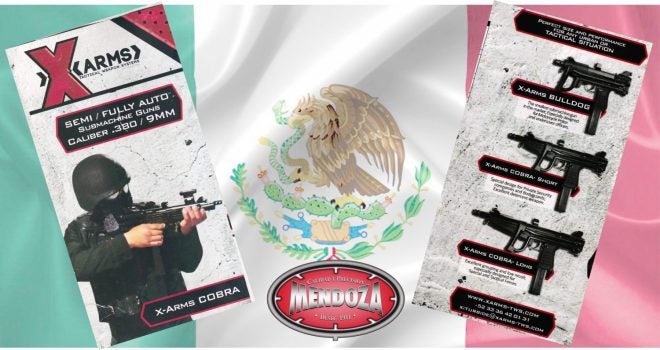Some days ago, while taking a look at some boxes of “unconventionally-filed” (messed, really) material in search of something, I came across a small brochure surviving from items collected at the 2013 LAAD Defence and Security Show in Rio de Janeiro describing a family of Mexican-made submachine guns being promoted by a company called X-Arms. Since the subject appears to be little known by the general public and a search in TFB-covered subjects was fruitless, I decided to give it some light.
The whole story started in the early 1930s, when Rafael Mendoza of Mexico’s Fábrica Nacional de Armas developed a gas-operated light machine gun which was subsequently adopted by the local Army as the Model C-1934 in 7x57mm, but became generally known as the “Mendoza” (Ian has described it in https://www.forgottenweapons.com/light-machine-guns/mexican-mendoza-lmg/). The designer later (the 1950s) established his own Productos Mendoza S.A. company in Mexico City, from which a few submachine gun designs emerged and, reportedly, were built in very limited numbers for the Mexican Army. Available in 9x19mm, .45 ACP, and .38 Super calibers with cyclic rate of fires of around 650 rounds per minute, the weapons looked more like beefed-up pistols/machine pistols (recoil spring around the barrel) with a tubular stock attached to the rear of the pistol grip. Belt-worn leather holsters were available for them.
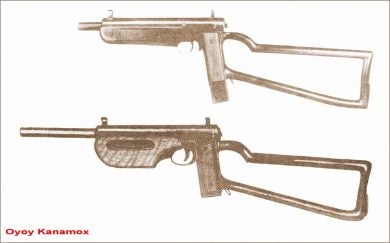
Short (254mm) and long (404mm) barrel variants of Rafael Mendoza’s buzzguns of the 1950s, which used 20-rd magazines. Although vaguely reported as having been used by Mexican forces in limited numbers, this is hard to confirm now.
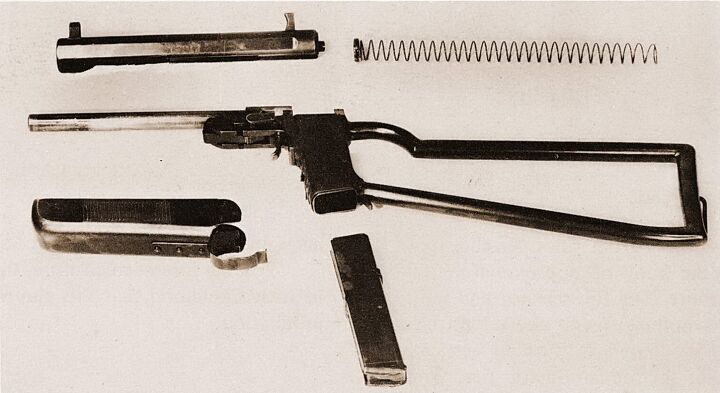
A field-stripped short-barrel Mendoza submachine gun (a.k.a. RM-3).
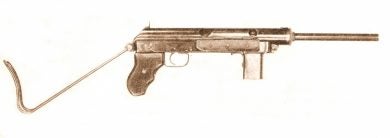
This is a previous (late 1940s-early 1950s) Mendoza SMG prototype in .45 ACP which used M3A1 magazines. Like in the Grease Gun, the large ejection port cover also acted as a safety feature when the bolt was in the open position, a stud in the cover, when closed, engaging the bolt-retracting slot.
On June 30, 1975, Hector Mendoza Orozco, Rafael’s son, filed a U.S. patent request for a “portable submachine gun”, which was granted (Number 3987571) on October 26, 1976. This was then initially promoted for sales as the Modelo HM-3 from the original Productos Mendoza S.A. concern, still headquartered in the Mexican capital city. Overall, it was pretty much his dad’s RM-3, including the fixed tubular stock, which the designer claimed was “always ready to use, without any delay in moving to the firing position”. Basic specifications of the selective fire (about 600 rpm, cyclic) weapon: Barrel length, 255mm; overall length, 635mm; loaded (32-rd magazine) weight, 3.35kg.
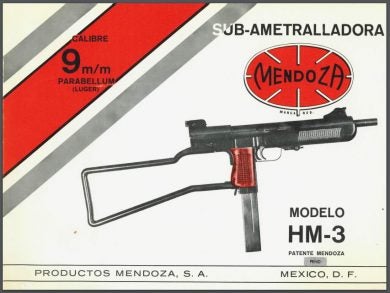
Cover of an early HM-3 promotional brochure.
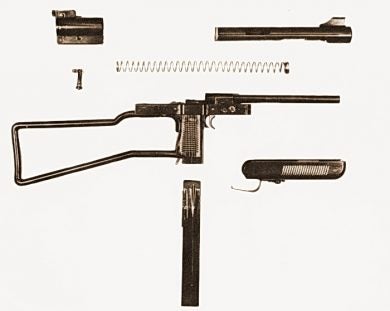
The family relationship between the RM-3 and the HM-3 is also clear when the latter is seen in this field-stripped condition.
Shortly afterward, some design improvements were introduced so that a “new”, handier Model HM-3 became available. Significantly, the fixed stock gave place to a side-folding unit, in which configuration (overall length, 400mm) the buttplate could act as a forward grip. Weapons in this new configuration were generally publicized in the 1980s, but actual sales (at least, in any significant number) to local military or police forces have never been fully confirmed.
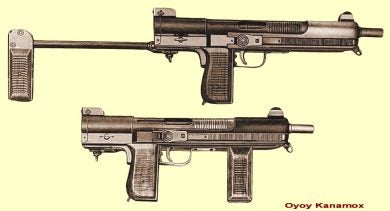
The HM-3 in the open and retracted stock configurations. A closer look at the illustration will show the cocking serrations machined on the sides of the bolt (exposed in most part), just ahead of the ejection window.
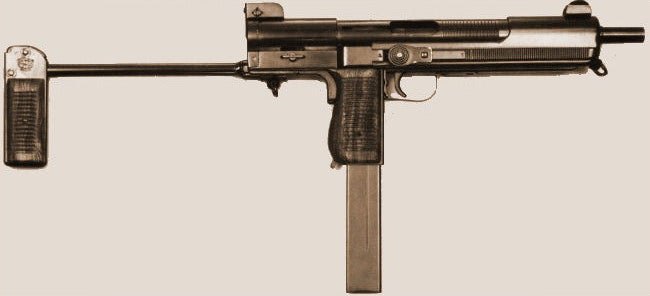
The subgun with the 32-round, single-position feed magazine inserted in the pistol grip. It fired from the open-bolt position (a safety lever is noticeable at the rear of the firing grip).
The next evolutionary step was the HM-3-S, which adopted a wire-type stock that folded upwards and onto the top of the gun, while the cocking serrations on the bolt gave place to a large bolted-on aluminum cocking piece, U-shaped in the center so as not to interfere with the sights use. A short, synthetic handguard was introduced, the gun finding service with Mexican police forces.
A two-part video showing the (somewhat complicated) stripping of an HM-3-S: https://www.youtube.com/watch?v=XO1VeNgXujU and https://www.youtube.com/watch?v=F2O4iqv_zYM .
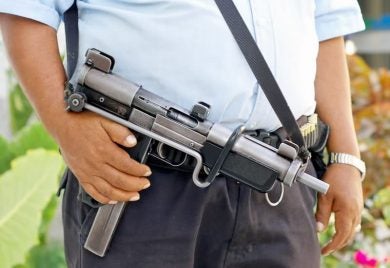
A rare photo of an HM-3-S in the hands of a Mexican police officer. (Image source: http://i55.tinypic.com/29by2l2.jpg via-www.ar.15.com/forums)
An additional updating of the Mendoza HM-3-S was present in guns having a side-folding metal stock and a reshaped polymer handguard (still including the trigger guard), while a flash-hider was added to the barrel. The grip-safety lever was dropped in favor of an applied-safety button on the firing grip, just aft of the trigger guard. A major change: the gun was semi-auto, only. The type entered service in 1997.
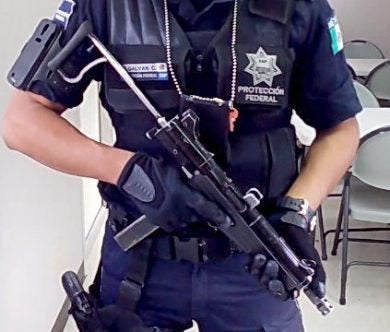
The updated HM-3-S in the hands of a member of Mexico’s Servicio de Protección Federal. A field-stripping video is available here: https://www.youtube.com/watch?v=WSZKyzc3Ack
By the end of 2009, Productos Mendoza S.A. had developed .380 ACP versions of the sub guns, called Cobra 380 and Bulldog 380, with some local marketing efforts taking place from 2011 on. An international sales campaign was underway in 2013 when the so-called X-Arms Tactical Weapon System was displayed at Rio de Janeiro’s 2013 LAAD Defence and Security Show (remember my opening paragraph?). The weapons received good attention from the exhibition visitors, mainly due to the fact of being from a generally-unknown manufacturer. This interest was to the point that two cased guns were eventually stolen (!) from the manufacturer’s booth, but the thieves were luckily spotted and arrested by local security before exiting the showgrounds.
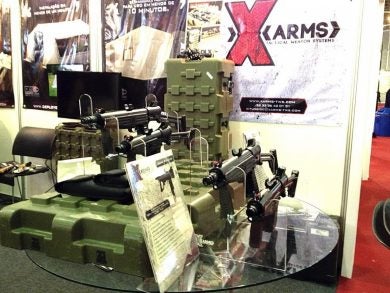
The X-Arms Tactical Weapon Systems booth at Rio de Janeiro’s LAAD Defence and Security Show, in April 2013.
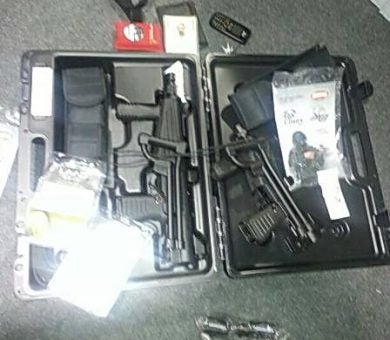
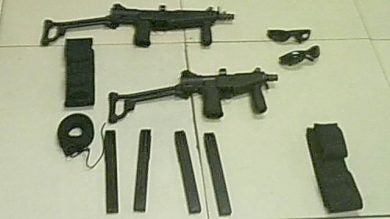
The two guns stolen from the X-Arms booth, after being recovered by members of the FNS – Força Nacional de Segurança (National Security Force) on duty at the 2013 LAAD Exhibition.
In very brief, here is a specifications summary of the three basic Mendoza models offered at the time, all firing from the closed-bolt position and available with 20 and 32-round magazines. Each gun came accompanied with two magazines, a two-mag pouch, magazine loader, and cleaning kit.
Cobra-Long (9x19mm/.380 ACP)
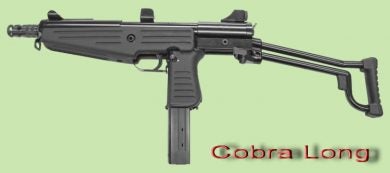
Barrel length, 255mm; overall length, 606mm; folded-stock length, 400mm; weight with the empty magazine, 3 kg; cyclic rate of fire, 550 rpm.
Cobra-Short (9x19mm/.380 ACP)
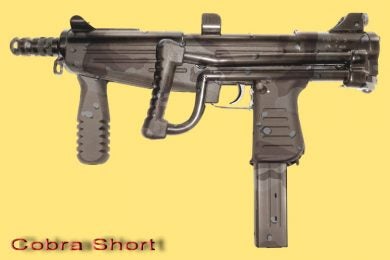
Barrel length, 210mm; overall length, 535mm; folded-stock length, 330mm; weight with the empty magazine, 2,9 kg; cyclic rate of fire, 700 rpm.
Bulldog (9x19mm/.380 ACP)
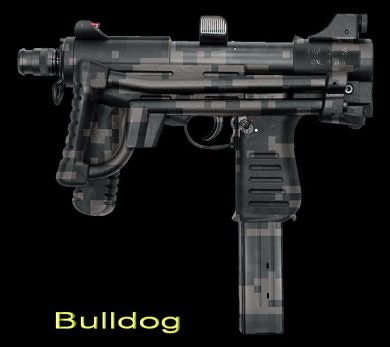
Barrel length, 153mm; overall length, 490mm; folded-stock length, 275mm; weight with the empty magazine, 2.6 kg; cyclic rate of fire, 800 rpm.
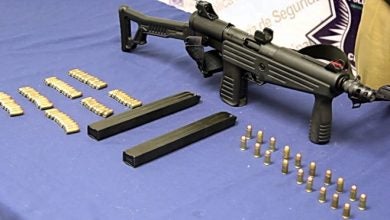
A semi-auto-only version of the Cobra Long in .380 ACP is available in the Mexican market for private security use, the example shown in the photo being involved in a criminal occurrence some years ago. Note slightly different folding stock.

The relative sizes of the Cobra Long and the shorty Bulldog.
Higher-res pics: https://imgur.com/a/yTHOp
 Your Privacy Choices
Your Privacy Choices
